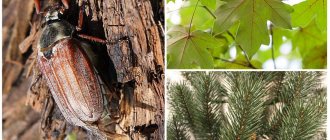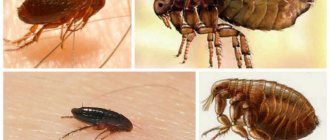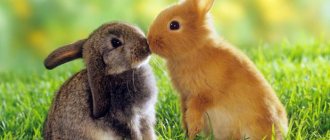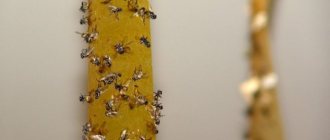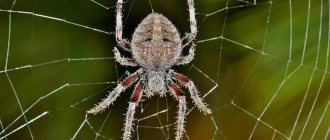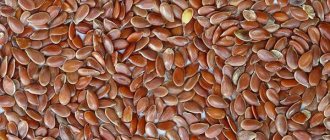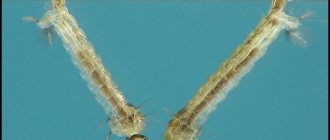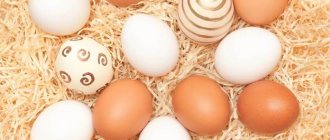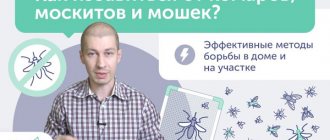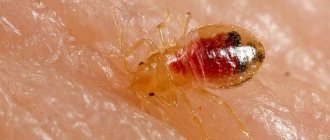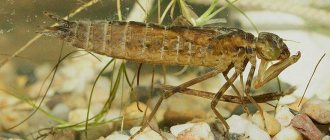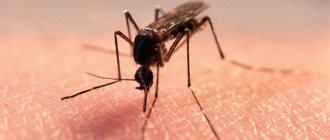In addition to repellents and insecticides, mosquito control mainly comes down to preventative methods using natural remedies to control the spread of these insects. Numerous methods rely on the use of animals that are natural predators of mosquitoes. As you know, the ecosystem is absolutely balanced, and if mosquitoes feed on our blood, it means that other animals feed on these insects. But who eats mosquito larvae and the mosquitoes themselves? Today we will try to answer this question.
Who eats adult mosquitoes
Many animals feed on mosquitoes throughout the warm season. From spring to autumn they are actively eaten:
- Birds. Swallows and swifts catch mosquitoes and midges in the air, and tits, orioles, and wrens catch mosquitoes in the bushes and treetops. In the grass and on the ground there are warblers, starlings, waders, birds, and finches.
- Amphibians – frogs, toads, newts. They watch for insects flying to the water and catch them with their sticky tongue.
- Reptiles - lizards, geckos, chameleons that catch insects in the grass or trees.
- Aquatic turtles – marsh turtles, trionics, red-eared turtles.
- Small fish of rivers and lakes - roach, whitefish, vendace, grayling, trout and other species that feed at the surface of the water. Some fish jump out after low-flying insects, others accurately shoot them down with a stream of water (for example, the spray fish).
- Arthropods - dragonflies, wasps, spiders, flycatchers and predatory beetles. With luck, a mosquito that lands on the ground or a blade of grass can be eaten by an ant or ground beetle.
- Chiroptera - bats. They deftly hunt insects in the evening and at night.
- Small mammals are hedgehogs and mice that catch mosquitoes in the grass.
- Predatory plants – flycatcher, sundew, butterwort, bladderwort, dewwort and others. Some plants stick flies and mosquitoes to themselves using a sticky secretion, while others actively catch them with special organs.
When temperatures drop (from autumn to spring), birds and small mammals find and eat those mosquitoes that have hibernated and hid in secluded crevices.
What can bloodsuckers hate?
There are a great many folk remedies for insect bites, however, not all of them are equally effective, we will tell you about the best:
- if you come to the forest for a picnic and have already lit a fire, then throw a bouquet of daisies into it, there will be much less midges and mosquitoes;
- When you arrive in the forest, smear the “star” on exposed areas of your body; insects are afraid of the smell of the balm;
- Citrus fruits, geranium, lavender and thyme are good at repelling mosquitoes; when going to the forest, you can safely use creams that contain the oils of these plants;
- Camphor alcohol perfectly repels mosquitoes, so sometimes you can resort to its help;
- On a forest hike, you can take a soda solution with you; it is prepared very simply: 1 teaspoon of soda per 1 glass of water; this product covers exposed skin in the forest.
Insect development stages
The female lays eggs mainly in stagnant bodies of water. Makes a clutch of 50-150 pieces at a time. Within 24 hours, larvae appear in the form of a small caterpillar or worm. They develop in water from 7 to 14 days depending on temperature conditions. At the end of the cycle, pupation occurs. Complex transformation processes take place inside the pupa; after a few days, an adult mosquito appears.
On a note!
Initially, the young generation gathers near a reservoir and feeds on nectar and pollen. Then they gather in flocks and mating begins. After this, the diet of mosquitoes changes depending on gender. The female becomes bloodthirsty, looking for prey - animals, birds, people. However, in the course of its life, the mosquito itself often becomes a victim.
Physiological needs
Insects accumulate their main reserves of energy at the larval stage; being an imago, they can freely be content with flower nectar. Glycogen is released from its carbohydrates, which is actively consumed during the flight. A male mosquito lives about 20 days.
In addition to carbohydrates, the female requires protein, lipids, and iron. It receives these components from the blood. With such a diet, it can live on average 40 days, in some cases it lives up to 60. If eggs are laid without replenishing protein reserves, the body weakens, and the insect dies after 20 days. At one time, the female is able to eat about 5.2 ml of blood, her weight is 3 g.
Who feeds on mosquitoes at the larval and pupal stages?
The breeding process lasts all summer. The female can live for about 45 days. The last generation, which did not have time to go through the entire development path, remains to winter in the water in the form of a pupa or bloodworm.
Mosquito larvae are food for insects
Mosquito larvae become food for many inhabitants of water bodies:
- dragonflies;
- swimming beetles;
- bedbugs;
- water striders;
- spiders;
- mites;
- aquatic turtles;
- crustaceans.
Fish, reptiles, and amphibians—frogs, toads, salamanders, newts, and lizards—feed on the young offspring of bloodsuckers. Since mosquito larvae are eaten by many fish, they are used by fishermen as bait and also fed to aquarium inhabitants. They love cyclid bloodworms, barbs, gourami, goldfish, and angelfish. Bloodworms attract crucian carp, carp, roach, perch, and lings.
Birds eat mosquitoes with great pleasure. The greatest gourmets are seagulls, phalaropes, geese, ducks, terns, swans, herons, and snipes.
On a note!
Larvifagous fish are a biological method of combating malaria mosquitoes and their larvae. In total there are about 200 species. They live calmly in shallow water, reproduce quickly, and are not picky about climatic conditions and habitat.
Aquarium fish food.
Mosquito larvae are excellent for feeding aquarium fish. Especially mosquito larvae are preferred by such types of fish as swordtails, pecelias, gouramis, gambusias and cichlids.
Larvivorous fish (larvivores) as a biological method of mosquito control.
One of the not very expensive and quite effective natural ways to counteract malaria is the use of larviphages - fish that feed on mosquito larvae. These animals, which feed on mosquitoes and other blood-sucking insects, number over two hundred subspecies. Of all the larviphages, platies and guppies are most often used to fight against spreaders of the malaria virus. They are also used as a remedy for midges. These animals, which feed on mosquitoes, are not picky about the environmental conditions in which they live, are distinguished by excellent reproductive qualities, and can be bred in small bodies of water.
Natural enemies of larvae
It is difficult to identify a specific taxonomic species that feeds on mosquitoes and their larvae. After all, the nutrients that make up the offspring of mosquitoes attract arthropods, fish and many birds. The hatched worms are consumed by dragonflies and crustaceans, small water striders and various bugs.
Among those that feed on the larvae of blood-sucking mosquitoes are:
- Fish.
- Frogs and toads.
- Various reptiles.
- River gulls.
- Dragonflies.
- Waterfowl.
It would take a lot of time to list all the names of animals that feed on mosquito larvae.
Detailed description
Mosquito larvae are of great interest to many animals, which belong to different taxonomic groups: from predatory insects to large birds.
In nature, most of the larvae are eaten by aquatic arthropods: swimming beetles, dragonflies, water striders, water bugs, mites, beetles, spiders and small crustaceans.
Among the highest-ranking animals, larval lovers include fish, amphibians - frogs, newts and salamanders, as well as various types of reptiles. The largest gourmets are considered to be waterfowl: phalaropes, river gulls, terns and Anseriformes.
Notes
- Pavlovsky E. N.
Methods for studying blood-sucking mosquitoes (Culicidae). - M.-L.: Publishing house. Academy of Sciences, 1935. - 176 p. - Sharkov A. A.
Blood-sucking mosquitoes (Diptera, Culicidae) of the Murmansk region / Executive editor A. S. Lutta. - Petro, 1980. - 96 p. - Kukharchuk L.P.
Ecology of blood-sucking mosquitoes (Diptera, Culicidae) of Siberia. - Novosibirsk: Nauka, 1981. - 232 p. - Nikolaeva N.V.
Ecology of larvae of blood-sucking mosquitoes in Southern Yamal. - Sverdlovsk: Ural Scientific Center of the USSR Academy of Sciences, 1980. - 67 p. - Vinogradova E. B., Karpova S. G.
Seasonal and daily rhythms of blood-sucking mosquitoes. - St. Petersburg: Zoological Institute of the Russian Academy of Sciences, 2010. - 238 p. — ISBN 978-5-98092-092-6. - Nekrasova L. S., Vigorov Yu. L.
Species features of population and biocenotic reactions of blood-sucking mosquitoes / Executive editor V. D. Bogdanov. - Ekaterinburg: Goschinsky, 2011. - 144 p. — ISBN 978-5-98829-027-8. - Life of animals. Volume 3. Arthropods: trilobites, chelicerates, trachea-breathers. Onychophora / ed. M. S. Gilyarova, F. N. Pravdina, ch. ed. V. E. Sokolov. — 2nd ed. - M.: Education, 1984. - P. 394. - 463 p.
- ↑
- Gornostaeva R. M., Danilov A. V.
Mosquitoes of Moscow and the Moscow region. - M.: KMK Scientific Press, 1999 - Etymological dictionary of Slavic languages. - M.: Nauka, 1983. - T. 10. - P. 169-171.
- Mullen, Gary;
Durden, Lance. Medical and Veterinary Entomology (undefined). - London: Academic Press, 2009. - ↑ Agrinsky N.I.
Insects and ticks that harm farm animals. - Parasitology and invasive animal diseases / M. Sh. Akbaev, A. A. Vodyanov, N. E. Kosminkov
and others; edited by M. Sh. Akbaeva. - (English). mosquito-taxonomic-inventory.info. Retrieved November 10, 2022.
- RG Estrada-Franco & GB Craig.
Biology, disease relationship and control of
Aedes albopictus
. - Washington, DC: Pan American Health Organization, 1995. - (Technical Paper No. 42). - Anna Petherick
(English).
Nature
(13 March 2008). Retrieved April 4, 2012. - . World Health Organization (WHO) website
. World Health Organization (WHO). Retrieved August 24, 2011. - (unavailable link). CDC (October 20, 2006). Retrieved October 4, 2022.
- ↑
- ↑
Opponents of the larvae
Mosquitoes lay a lot of future offspring, as the larvae often die. Most often this happens due to the following reasons:
- bad weather conditions, unstable air temperature;
- their absorption by inhabitants of reservoirs, amphibians and fish, for which they act as the main source of food;
- unfavorable environmental situation, for example, due to water pollution or the presence of an oil film, which deprives them of the opportunity to fully breathe.
However, the disappearance of these creatures is quickly replaced, since female mosquitoes are extremely fertile, and people cannot hope for a decrease in the number of this population.
Mosquitoes lay a lot of future offspring, as the larvae often die
Reproduction
Mosquitoes feed on flower nectar. Even the females. But females need blood for successful and abundant oviposition. This is what causes their “bloodthirstiness”.
The female common mosquito (squeaker) attracts the male with a characteristic sound. That's why she still has her halteres. It does not buzz, but squeaks solely because of its size. Wings that are too small cannot produce a bass hum. If you hear a squeak in a swarm of mosquitoes, you can be sure that there are also females thirsty for blood there.
Even scientists have not yet been able to tell everything about mosquitoes when writing dissertations. However, many interesting facts about mosquitoes have been collected and you can get a general idea of how the bloodsucker that prevents you from sleeping works, and why it prevents you from sleeping with its squeaking.
Who eats adult mosquitoes?
Numerous mosquito populations are able to survive only due to high fecundity. The prevalence of mosquitoes is very wide, so they are food for some representatives of flora and fauna.
In different regions, some bird species are completely dependent on the abundance of mosquitoes and their larvae. There will be no more insects, fewer birds, and so on. That is, in nature there is a tiering system, where mosquitoes occupy the lower layers in the food chain.
Dragonflies
Every summer we can't wait for the dragonflies to come out. It is with their appearance that there are fewer bloodsuckers. Dragonflies fly in flocks, hatch from bodies of water and begin their migration to places where there is a lot of grass, trees, and therefore food. Big-eyed insects fly in flocks and eat mosquitoes in flight. The abundance of dragonflies occurs at the end of June, beginning of July.
In addition to dragonflies, mosquitoes are tasty food for:
- Insectivorous birds. Swifts and swallows eat insects in flight over a pond. Orioles and tits feed on mosquitoes in the bushes;
- Reptiles and amphibians. Toads, frogs, iguanas, spreading their long tongues, swallow a flying mosquito with lightning speed. Chameleons live in the trees, geckos and lizards live in the grass, and they can also feast on adult adults;
- Rodents and other small representatives of mammals - these are hedgehogs and mice that live in the grass and are not averse to eating a few mosquitoes;
- Centipedes, spiders, crustaceans, dragonflies, wasps;
- Fish, some of their species, that are capable of catching insects from the surface of the water. Among them are trout, vendace, whitefish, roach;
- Plants that have sticky secretions that attract insects.
Each mosquito goes through several stages in its development:
- oviposition;
- hatching of larvae;
- appearance of the pupa;
- adult insect (imago).
Life cycle of a mosquito
At each stage, it is eaten by representatives of flora and fauna. An adult mosquito is very easy to catch and eat, since it has a very small body, it cannot harm a larger insect, and therefore becomes a victim in the paws of, for example, a spider or a frog.
Many birds live near bodies of water, and, as you know, there are a lot of mosquitoes there, so they feed on all mosquito breeding elements (larvae, eggs, pupae).
But if you think that this causes fewer mosquitoes, then this is a misconception, since having eaten one individual, several will appear in its place. This is how nature works so that insect populations renew themselves.
Who eats mosquito larvae, pupae and eggs?
Mosquito larvae and eggs are no less nutritious than adults. Therefore, they are eaten with great pleasure. But who?
Mosquito larva under a microscope
Female mosquitoes lay eggs in puddles and water. Sometimes, if there is no pond nearby, then in tall grass. If this happens in water, then the eggs sink to the bottom or float in a sticky state on the surface of a lake or river.
Then, with the onset of hot weather, larvae hatch from them. Mosquito larvae are called bloodworms and are presented in the form of red worms spinning in water. It can be found on the shelves of hunting stores as bait for fish.
These components of the mosquito's reproductive system can feed on:
- Arthropods living near a reservoir: mites, water striders, crustaceans, diving beetles;
- The larvae floating in the water are very actively eaten by wild species of guppies and gambusia. These fish are specially bred to eat eggs and bloodworms in the water. But unfortunately, this is abroad, not in Russia;
- Green red-cheeked turtles, which themselves live in water;
- Birds that fly in large flocks over a pond: seagulls, wild ducks and geese. They destroy a lot of eggs and larvae by passing water through their beaks.
Having bought bloodworms in a store (frozen in winter, live in summer), many aquarium fish lovers use it as food for their pets.
Who eats adult insects
Of interest are not only those representatives of the fauna that eat mosquito larvae, but also species that feed on adult individuals. After all, adult mosquitoes cause a lot of trouble for people, as they interfere with normal rest, bite and provoke allergic reactions.
Every year people look forward to seeing dragonflies appear in the swamp. After all, they eat mosquitoes. Dragonflies move only in numerous flocks, looking for places where mosquitoes and their offspring gather. They catch them on the fly or during the rest period. Since mass concentrations of dragonflies are observed in early summer, people are interested in what other animals feed on mosquitoes. Mosquitoes are consumed by:
- Birds that prefer insects. These species include orioles, swifts, and swallows. They catch pests on the fly or look for them in the bushes. Undoubtedly, other bird species eat mosquitoes, although in small quantities.
- Reptiles. Children and adults know that a frog eats a mosquito. They use long tongues to catch. This fishing method is used by iguanas, lizards and chameleons. Adults contain nutrients that are necessary for the normal development of reptiles.
- Rodents. Field mice and hedgehogs live in the grass and bushes. They consume small numbers of mosquitoes, but still contribute to population declines.
- Crustaceans and spiders. To catch pests, spiders use cobwebs, weaving them in places where insects may accumulate.
- Fish. There are phenotypes in nature that feed on adult pests. These include vendace and roach. They catch insects that move near water. Active catching of fish is carried out at the moment when mosquitoes dump their offspring into the water.
Mosquito populations are partially reduced by plants that emit aromas and juices that are attractive to insects. Adult pests that fly up to such plants stick and die.
A considerable number of individuals die due to the fact that people use insecticidal preparations, chemicals, folk methods and devices. Some drugs affect adult insects and their offspring.
The number of enemies of adult mosquitoes, bloodworms and eggs is enormous. Caution against blood-sucking insects should be exercised not only at night, but also during the daytime. Therefore, mosquitoes form a huge number of clutches so that their population does not decrease.
Amphibian breathing
Amphibians breathe through their lungs and skin. The grass frog receives 33% of oxygen through its skin. The exchange of gases through the skin with the environment in amphibians occurs only through the water film, so the skin is constantly moistened with mucus produced by numerous glands. In the sun, the film on the skin dries out and prevents moisture loss.
For protection, toads have poisonous glands that secrete substances with a pungent odor, a very bitter taste, a burning and emetic effect. After all, they cannot move quickly and escape from the hunter. The venom of gray and green toads is not dangerous to humans, especially since it is released only under mechanical pressure.
Spadefoot, accidentally dug out of the ground
Practical significance of bloodworms
Another name for mosquito larvae is bloodworm. Since not only toads, but also fish actively feed on these small worms, they are often used by aquarists, as well as experienced fishermen. Bloodworms go on sale after careful packaging. This is because small larvae are suitable only for aquarium phenotypes, but large ones are suitable for catching river fish. How actively a barb or gudgeon will consume mosquito offspring depends on the degree of its freshness and proper preparation. Therefore, experienced fishermen purchase larvae for feeding only in specialized departments.
Description and classification
The mosquito larva is called a bloodworm. Their color may vary depending on the species they belong to. In particular:
- The squeak mosquito has brown or black larvae.
- Malaria mosquitoes usually have green-colored babies.
- The bell is characterized by a red color.
Such creatures are born from mosquito eggs, which are laid directly in the water. Most often this happens in ponds, large puddles or pits with rainwater.
At the time of birth, the size of the larvae usually does not exceed 2 millimeters; over time they can increase to 1 centimeter. They have 2 eyes, and on the ring of the body there is a special tube through which the process of their breathing is carried out. In addition, bristles are located throughout the body of the individual, thanks to which it can move in the water; they are called swimming hairs.
In an effort to breathe, they settle down, raising their tails up, on the surface of the reservoir; after absorbing oxygen, the larvae set off on their further journey. Although water is their natural habitat, they can dive for only a short time; they can spend no more than 15 minutes at depth, then the available air supply runs out.
Appearance
Hatched bloodsuckers resemble small worms that grow and develop quickly. They differ from each other in the structure of the body and behavior depending on the species. Among them the following varieties are distinguished:
- Malarial (another name for mosquito larvae is anopheles). Insects have a large head with oral brushes for eating, an abdomen of several segments, and a chest. The color of the body is green. There is no respiratory tube, but there are special spiracles located on the sides of the body. They live on the surface of the water.
- Zvontsy . Their size reaches 3 cm. The color of the body is red (due to the high hemoglobin content). The level of iron allows them to survive in conditions of acute oxygen deficiency. The oral apparatus is underdeveloped. They live in dense thickets of plants, spend most of their time in the bottom silt, but float up to breathe. They use their own saliva and nearby debris to create a tube-shaped house.
- Centipedes . They resemble gray-brown worms with huge heads. Behind the abdomen they have a pair of spiracles surrounded by fleshy growths. At the end of the body there is a star-shaped mouthparts.
Mosquito larvae may differ due to species characteristics
The optimal temperature for larval development is considered to be +25…30°C. Some insects quickly adapt to harsh conditions, so they can live calmly at +10...35°C. The larvae often live in polluted water bodies, but life under the oily film of petroleum products is impossible for them.
This video explains how to kill mosquito larvae:
Insectivorous birds
Birds eat insects. This is no longer a secret. The main birds that massively destroy mosquitoes are swallows. However, the problem is that mosquitoes are only part of the swallow's diet. These birds do not focus their attention on mosquitoes, simply eating all the insects in a row.
An interesting fact is worth noting. It lies in the fact that in our country mosquitoes over the past 50 years have become much larger than before, while the birds of prey that exterminate them have become considerably smaller.
“They are attacking our area in hordes”
A resident of the Gagarinsky district, Elena Goncharova, told Moscow 24 that in their area this year there is a real invasion of poplar moths - small flying insects that feed on the foliage of trees.
“People are suffering from moths, but the worst thing is that it has begun to harm other trees. The last two days there have been fewer adults. Apparently, it has something to do with the weather or something else, but until September it will continue to fly, appearing in waves, sometimes larger, sometimes smaller. You can fight alone only within the confines of an apartment. I have special, small nets – they deter moths as much as possible,” explained the city dweller.
Residents of the area even complained to the Moscow authorities about the pest invasion and wrote an appeal to the city’s environmental management department to understand how to deal with insects.
The invasion of these pests, which attack our area in hordes in the evening, not only affects the level of living comfort of people in our area, but has already begun to have a detrimental effect on other tree species. In particular, maples, aspens, fruit trees, and shrubs began to be affected. Adult individuals cover the walls and ceilings of entrances; going outside in the evening is difficult due to the huge number of flying individuals. from an appeal from residents of the Gagarinsky district of the capital
Ekaterina Titova, who lives in the Izmailovo area, also observed a “terrible accumulation of moths” this year. She said that neither repellents nor a vacuum cleaner helped in the fight against it, and the moth left marks on the walls. But thanks to active residents, the problem was partially solved, and the number of insects became “a million times less.”
“Active residents of the building on Izmailovsky Boulevard drew up a group letter, we signed it - just a few apartments. They took it to the head of the council - and the diseased poplar was cut down. Happiness! No one expected this to work,” the Muscovite explained to Moskva 24.
Gambusia
Gambusia is a small fish that loves to kill mosquito larvae.
In common parlance, this type of fish is also known as “mosquito-eating fish.”
Gambusia Affinis is a small (up to 5 cm), silvery fish. Gambusia eats mosquitoes (at the larval stage) with such an appetite as if it were living its last day. She herself is a native of America. But in history there is the fact that Gambusia saved Italy from the invasion of malaria mosquitoes. In the 1920s, many specimens of this fish were transported to Italy, and thus managed to overcome the malaria epidemic.
Tench
One of the largest eaters of mosquito larvae is tench. For this reason, this fish is widely used for biological mosquito control.
Tench is a fish of the Cyprinidae family, about 35 cm long, which can weigh up to 5 kg. It lives in freshwater basins and is widespread in Europe and Western Asia. As a habitat, it prefers muddy bottoms and stagnant waters rich in aquatic plants, on which it lays its eggs, between May and June.
The adult fish eats up to 1,500 mosquito larvae every day, becoming one of the most used natural predators in the fight against this pest.
Diet
The mosquito remains in the larval stage within 4 weeks, the duration is related to environmental weather conditions. During this period, the creature molts repeatedly and increases significantly in size. The temperature required for the development of larvae varies from 10 to 35 degrees; the optimum is considered to be between 25 and 30 degrees. In parallel with the length, the creature’s weight also increases; according to available data, it becomes 500 times larger per month.
The mosquito larva feeds mainly on microorganisms present in the reservoir, that is, the most primitive algae and decaying substances of organic origin. To provide nutrition, this creature filters 1 liter of water volume throughout the day. The next stage of development is the formation of a pupa , which is already a more complex natural creation.
